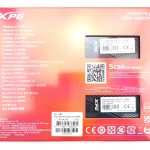Today we’re looking at the next high-performance upgrade level of DDR5 memory, in the form of the ADATA XPG LANCER RGB DDR5-6000 CL40 2x 16 GB kit. Our sample is based on the SK Hynix M-Die memory chips, which currently offer the highest performance and overclocking potential for DDR5. Even though the XMP profile looks rather unsuspicious, it hides a lot of reserves that we will use in today’s test. That much I’m gonna spoil in advance already.
The LANCER series is ADATA XPG’s mid-range DDR5, with two versions available, one being DDR5-5200 with timings 38-38-38, and DDR5-6000 with timings 40-40-40, both at 1.35V in XMP profile. The modules are single-sided, single-ranked, have a capacity of 16 GB and are available alone or as a kit of 2. We will take a closer look at the combination of the latter with the product number AX5U6000C4016G-DCLARBK today. Above the LANCER series, the product portfolio also includes the CASTER modules with up to 7000 Mbps and, as a cheaper alternative, the HUNTER series with 5200 Mbps.
Disclaimer: I would like to point out in advance that the kit we tested today uses “Hynix M-Die” memory ICs, which are decisive for the achieved OC and benchmark results. Meanwhile, according to forum reports, the kit is allegedly also sold with Samsung ICs under the same SKU number, which can influence the performance potential. ADATA XPG has not provided us a statement on this yet.
Unboxing and design
Packaging and design of the modules are very similar to late DDR4 modules from ADATA, which we also had in our test last yeat. The outer carton with pearl effect already suggests some special contents.
Printed on the front next to the product name we find the clock frequency and capacity of the modules as well as the compatible RGB software products of the motherboard manufacturers. The SKU number and the XMP profile are attached to a sticker on the back and the two modules with their serial numbers can already be identified through two viewing windows. Finally, we find a reference to the “Lifetime Warranty” here. Inside the two modules are housed in a carrier frame made from transparent plastic.
The modules themselves are again very similar to their DDR4 predecessor, with the light element and the shape of the heatsink effectively remaining the same. Only the texture and the printing are slightly changed. So, one of the diagonally separated sections is black anodized and brushed with a white “XPG” imprint and the other side has parallel gray stripes and “DDR5” lettering printed on it. Near the top edge of the modules, the gap between the two optical cooler halves is filled with the lighting element made of white acrylic plastic.
The recess for the lighting element is not completely centered, but slightly offset. On its center, however, there is again a black “XPG” imprint as a contrast to the lighting.
You can already see from below that the modules are single-sided, which also fits with the capacity of 16 GB and the standard IC size of 16 Gbit for DDR5. The bare side of the board is equipped with a foam spacer to keep the distance to the heatsink almost identical on both sides. If we look at the modules from the side of the DIMM slot latches, we can nicely see the sandwich of anodized aluminum heatsink halves and the light element in the center, which is placed on the PCB and aligns the heatsink halves from both sides at the upper edge.
datasheet_xpg_lancer_rgb_ddr5_dram_20211118
- 1 - Unboxing and design
- 2 - Dimensions and SPD information
- 3 - Teardown and PCB analysis
- 4 - Test systems and methodology
- 5 - Heatsink peformance and overclocking potential
- 6 - Synthetics – AIDA64, Geekbench 3, SPI32M, LinpackXtreme
- 7 - Gaming – SoTR, CS: GO, Cyberpunk 2077
- 8 - RGB lighting and conclusion









































42 Antworten
Kommentar
Lade neue Kommentare
Urgestein
1
Mitglied
Urgestein
Urgestein
Veteran
Veteran
Urgestein
1
Urgestein
Urgestein
Urgestein
Mitglied
Mitglied
Mitglied
Mitglied
Mitglied
Mitglied
Mitglied
Alle Kommentare lesen unter igor´sLAB Community →